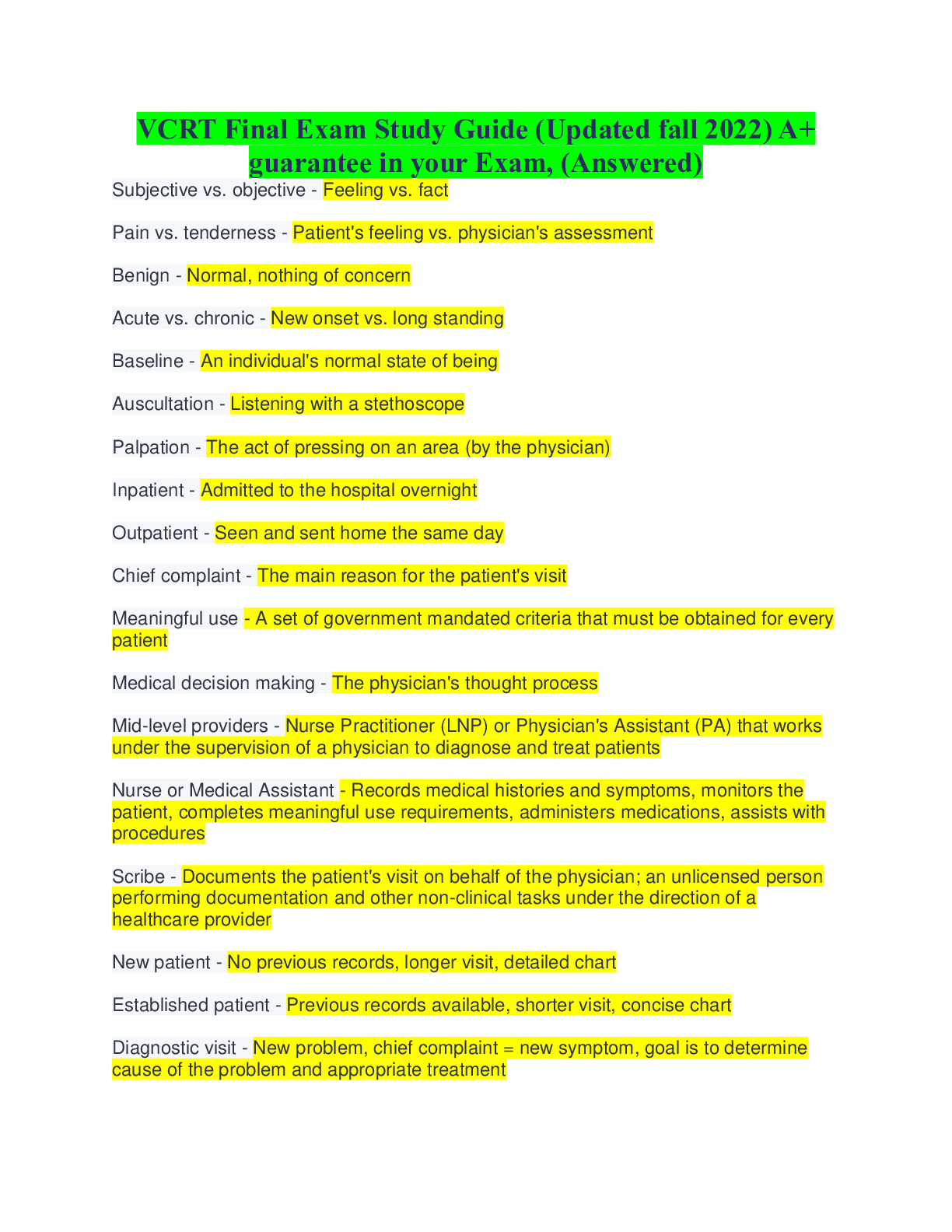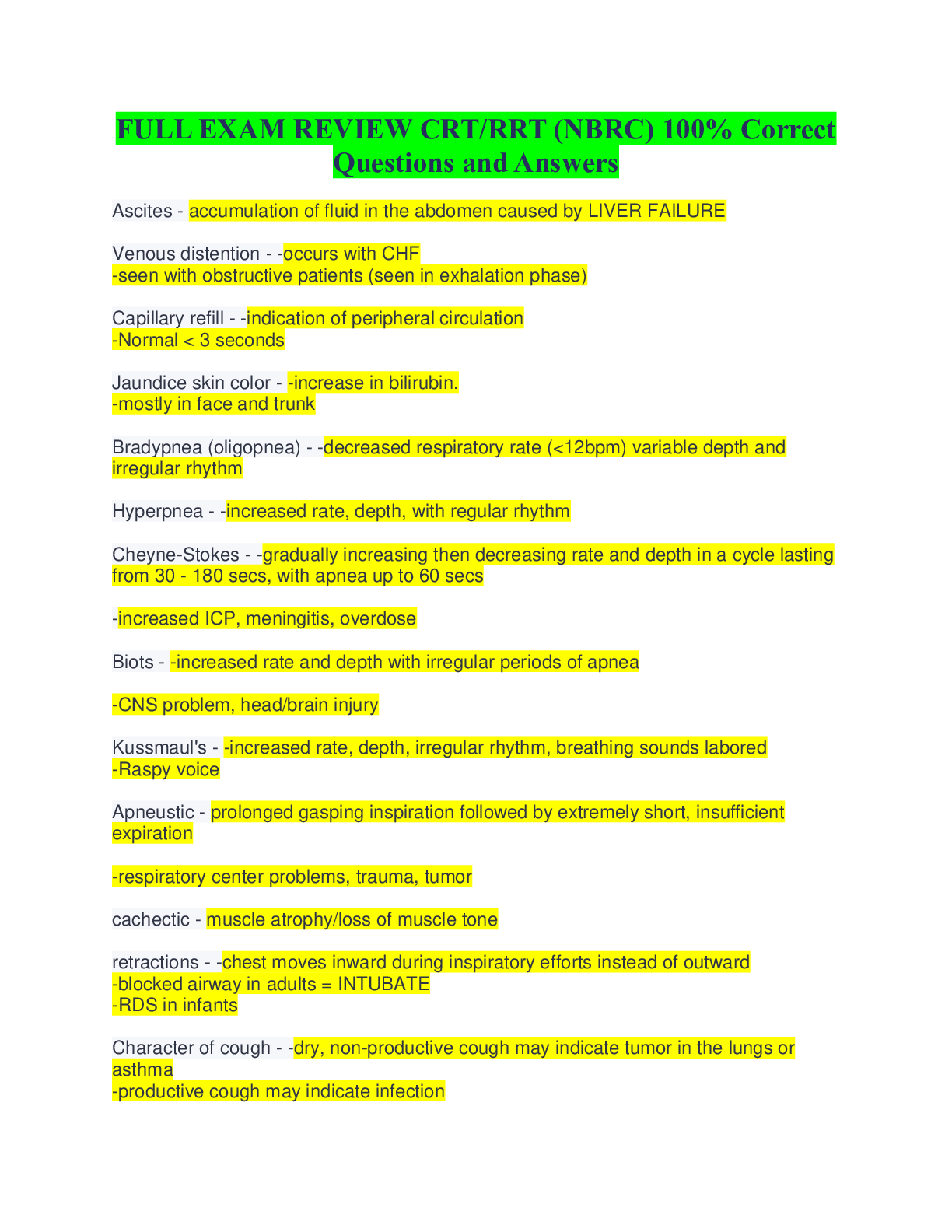*NURSING > QUESTIONS & ANSWERS > ATI NURSING CARE OF THE CHILD 2019/2020 PROCTORED EXAM STUDY GUIDE (All)
ATI NURSING CARE OF THE CHILD 2019/2020 PROCTORED EXAM STUDY GUIDE
Document Content and Description Below
A nurse is providing education to the parent of a child who has cystic fibrosis and has a prolapsed rectum. The nurse should teach that which of the following is a cause of this complication: a. Bulky... stools b. Weakened rectal sphincter c. Elevated pancreatic enzymes d. Decreased intra-abdominal pressure 2. A pre-schooler is admitted to the emergency department with full thickness third degree burn over 45% of his body. Which of the following actions should the nurse take first: a. Administer IV morphine b. Administer IV antibiotics c. Administer IV solutions d. Administer total parenteral nutrition 3. A nurse is providing teaching to a parent of a pre-schooler who has Tinea Capitis. Which of the following should the nurse include in the teaching: a. Apply 1 to 20 burrow’s solution compressed to the lesions b. Apply hydrocortisone cream to the lesions twice daily c. Seal and wash toys in plastic bag for two weeks d. Leave the shampoo on the scalp for 5 to 10 minutes 4. A nurse is caring for a child who has sickle cell anemia. Which of the following signs of acute chest syndrome should the nurse report to the primary care provide immediately: a. Congestive cough b. Dilute hearing c. Hct of 10g/dl d. Systolic murmur 5. A nurse is assessing a 3month old infant for suspected intussusception. Which of the following findings should the nurse expect: a. Jelly-like stool b. Board-like abdomen c. Projectile vomiting d. Oliguria 6. A nurse is planning a teaching session for parents regarding infant development. Which of the following parent activities regarding play should the nurse include in the teaching: a. Encourage the infant in one on one play b. Promote play with other infants c. Provide visual stimulation with pastel colored toys d. Give the infant a large piece puzzle 7. A school-aged child with sickle cell anemia has been admitted in vaso- occlusive crisis. Which of the following assessment findings should the nurse recognize as an emergency? a. Slurred speech-NOT PRIORITY b. Fever of 38.30 C (1010 F) c. Hematuria d. Pain level of 7 on a faces scale 8. A nurse in an emergency department is assessing a child who was in a motor vehicle accident. Which of the following assessment findings require immediate intervention: a. Dilated and fixed pupils b. Disorientation to person and place c. Positive Babinski reflex d. Restless and irritable 9. A nurse is assessing a child who has sustained a head injury. During the assessment, the nurse observes clear drainage leaking from the child’s nose. Which of the following actions should the nurse take? a. Perform naso-tracheal suctioning b. Test the nasal secretions for glucose c. Maintain direct lighting on the child d. Lower the head of the bed 10. A nurse at a provider’s office is preparing a newborn for a routine heel puncture. Which of the following actions should the nurse take? a. Administer tolectin (tolmetin) prior to the procedure b. Apply EMLA cream to the heel after the procedure c. Prepare concentrated sucrose for oral administration d. Place the new born in an extended position 11. A nurse is caring for a child who has rheumatic fever. Which of the following is an indication that the child has developed carditis? a. Carotid bruit b. Chest pain c. Hypotension d. Cyanosis 12. A parent calls the clinic asking for pinworm testing information, the nurse should advise the parent to perform the test at which of the following times? a. Immediately after child has a bowel movement b. After being on a clear diet for 24hrs c. Immediately after the child awakes in the morning d. After soaking for 20 minutes in a warm bath 13. A nurse is educating the parents of an infant who has mild gastroesophageal reflux. Which dietary adjustment should the nurse recommend? a. Provide a little sprout formula b. Administer nasogastric feedings c. Thicken feedings with rice cereal d. Place infant in a lateral position for one hour after feedings 14. A nurse is teaching an adolescent client about managing asthma and using a peak respiratory flow meter. Which of the following by the client demonstrates an understanding of the teaching: a. I will use my peak flow meter whenever I feel short of breath b. I will continue to take my medication when my peak flow meter is in the green zone c. I need to use the average of three readings when I measure my flow rate d. My asthma is being controlled if my flow rate is in the yellow zone 15. A nurse is instructing the parent of an infant who has clubfeet and has cast applied. Which of the following statements by the parent indicates a need for further teaching: a. My baby will need to return to have his cast changed weekly b. I need to check my baby’s toes for any discolorations daily c. My baby will need to have surgery at 18 months if his toes aren’t fixed d. I will check the skin around my baby’s cast at every diaper change. 16. A nurse assesses an infant that is admitted for acute gastroenteritis. Which of the following is the priority finding? a. Decreased tears b. Capillary refill of 5 seconds c. Heart rate 150/min d. Dry mucous membranes 17. A nurse is planning to teach a nutrition class for preschoolers. Which of the following is an appropriate instructional strategy? (Select all that apply.) a. Offer written handouts b. Limit the teaching session to 45 minutes c. Use simple language d. Incorporate games into the lesson e. Provide concrete examples 18. A nurse is caring for a toddler who has a fever, high-pitched cry, irritability and vomiting. Which of the following is an appropriate action for the nurse to take? a. Administer 81mg of Aspirin b. Place the toddler in a cold water bath c. Place the toddler in a supine position d. Pad the rails of the bed 19. A nurse is reviewing the morning lab results for an infant who is receiving Digoxin and Lasix for the treatment of heart failure. Which of the following should the nurse report to the provider: a. Sodium 140 mEq/L b. Calcium 10.2 mg/dL c. Chloride 100 mEq/L d. Potassium 3.2 mEq/L 20. A nurse is caring for a school aged child who has an arm cast applied 8 hours ago. Which of the following findings should alert the nurse of complications related to the casting: a. Child rates pain of 5 on a scale from 0 to 10 b. Child’s hands are cool bilaterally c. Child reports tightness at the wrist d. Child grasp is weak 21. A nurse is performing a neurological examination on a 15-month-old child. Which of the following is an expected normal finding? a. Negative Babinski reflex b. Presence of Moro reflex c. Absence of corneal reflexes d. Positive palmar grasp 22. Which of the following actions indicates to the nurse that the parent of a preschooler is using an age-appropriate disciplinary technique? a. Explains to the child why her behavior is unacceptable ? b. Places the child in time out after misbehaving c. Allows the child to choose the consequence for her misbehavior d. Assigns an extra chore for the misbehavior 23. A nurse is caring for an infant who is pre-operative for the treatment of mild myelomeningocele. In which of the following positions should the nurse place the infant: a. Side-lying b. Supine c. Prone d. Semi-Fowlers 24. A nurse is providing postoperative care for an infant who has pyloric stenosis. Which of the following actions should the nurse take? a. Use a re-breather mask to provide oxygen b. Place the infant in a supine position c. Initiate feedings with clear fluids d. Weigh the infant every 48 hours 25. A nurse is admitting a child with tonic clonic seizures. Which of the following is the priority to have in the room: a. Pulse ox meter b. Oxygen therapy c. Valve mask d. Suction equipment 26. An infant has had a cardiac catheterization with a right femoral entry to diagnose a possible congenital heart defect. Following this procedure, the nurse should be concerned about which of the following: a. Cool toes on the right foot b. Weak pedal pulses on both feet c. Positive Babinski on both feet d. Erythema on the right foot 27. A nurse is developing a health program for the parents of school age females. Which of the following regarding sexual maturation should the nurse include: a. Higher body fat content is often highly associated with earlier onset of menarche b. Pubic hair is typically present prior to breast development c. Ovulation begins after sexual maturation is complete d. Menarche signals the beginning of puberty 28. A nurse is assessing a child who has measles (rubella). Which of the following findings should the nurse expect? a. Vesicular rash b. Koplik spots c. Para oximal d. Sternal retractions 29. On the way to the emergency department a parents reports a child accidentally ingested overdose acetaminophen. Which of the following medications should the nurse prepare to administer? a. Naloxone b. Diphenhydramine c. Glucagon d. Acetylcysteine 30. A nurse preceptor is working with a newly licensed nurse in caring for a child that is postoperative for a placement of a tracheaosophageal shunt. Which of the following statements made by the newly licensed nurse indicates a need of further teaching: a. I will ensure that pressure is not applied to the shunt valve b. I will pump the shunt every two hours c. I will keep the head of the bed flat for two hours d. I will offer prescribed pain medication as needed 31. A nurse is teaching the parents of a toddler who has a new prescription for an oral iron supplement. Which of the following should the nurse recommend for administration with the medication to increase its absorption: a. A protein source b. Orange juice c. Milk d. A whole grain fiber 32. A nurse is evaluating the anticipatory grieving of a parent do to the impending loss of a child. Which response indicates a need for further assessment by the nurse: a. “We will encourage our other children to be involved in the care of our child.” b. “We have contacted hospice to ensure our child does not have pain.” c. “We understand our child will be most comfortable in a hospital.” d. “We have given our child permission to die.” 33. A nurse is assessing an adolescent female. The adolescent’s mother tells the nurse she is concerned that her daughter is too thin. Which of the following assessment findings are consistent with anorexia nervosa? a. Hyperactive deep tendon reflexes b. Lanugo over the back c. Oily skin with acne d. Elevated body temperature 34. A nurse is educating the family of a child regarding hospice care. Which of the following should the nurse include in the teaching: a. “The hospice staff will be the primary care giver of this child.” b. “Hospice staff consider the needs of the family as important as those of this child.” c. “Hospice care will end with the death of the child.” d. “The priority of hospice care is to provide curative treatment for the child.” 35. A nurse is caring for a child who has acute renal failure. Which of the following findings is of priority concern to the nurse? a. Hyperphosphatemia b. Hyponatremia c. Hypocalcemia d. Hyperkalemia 36. A nurse is caring for a breast-feeding infant who is given amoxicillin for an upper respiratory infection. Assessment of the mouth reveals white patches that would not scrape off. Which of the following nursing interventions is appropriate? a. Offer the infant water before feedings b. Discontinue the amoxicillin c. Administer antifungal medication after feedings d. Give the infant formula instead of breast milk 37. A nurse is caring for an infant admitted with hydrocephalus, and increased intracranial pressure. Which of the following findings should the nurse expect? a. Decreased occipital frontal circumference b. A depressed fontanel c. Unresponsive to physical stimuli d. A high-pitched cry 38. A nurse is caring for a toddler who is postoperative following the repair of a cleft palate. Which of the following interventions by the nurse is appropriate? a. Restrain arms at the elbows b. Feed with a spoon c. Monitor oral temperature d. Provide pacifier for comfort 39. A parent of an infant who is taking Digoxin (Lanoxin) phones the nurse at a clinic because the child has vomited the medication. Which of the following is the priority nursing intervention? a. Tell the father that a repeat dose of medication should not be given b. Verify the prescribed medication regimen c. Determine if the infant has been exposed to others who are ill d. Ask the father about the infant’s urinary output. 40. A nurse is providing teaching to the parents of a toddler about injury prevention. Which of the following safety measure should the nurse include in the teaching? a. Select the toy box with the heavy hand slid b. Provide balloons for play c. Check clothing for loose buttons d. Offer grapes as a snack food 41. A nurse at a pediatric clinic assessing the fluid in caloric intake for an infant who weighs 5 kg and fed a commercial infant formula. The provider recommends that the infants eat just at least 2.5 mg of formula per kg/day, and the formula contains 20 calories per ounce. What is the minimum number of calories per day the infant should consume? CONTINUED...................DOWNLOAD FOR MORE REVISION TO BEST SCORES [Show More]
Last updated: 1 year ago
Preview 1 out of 11 pages
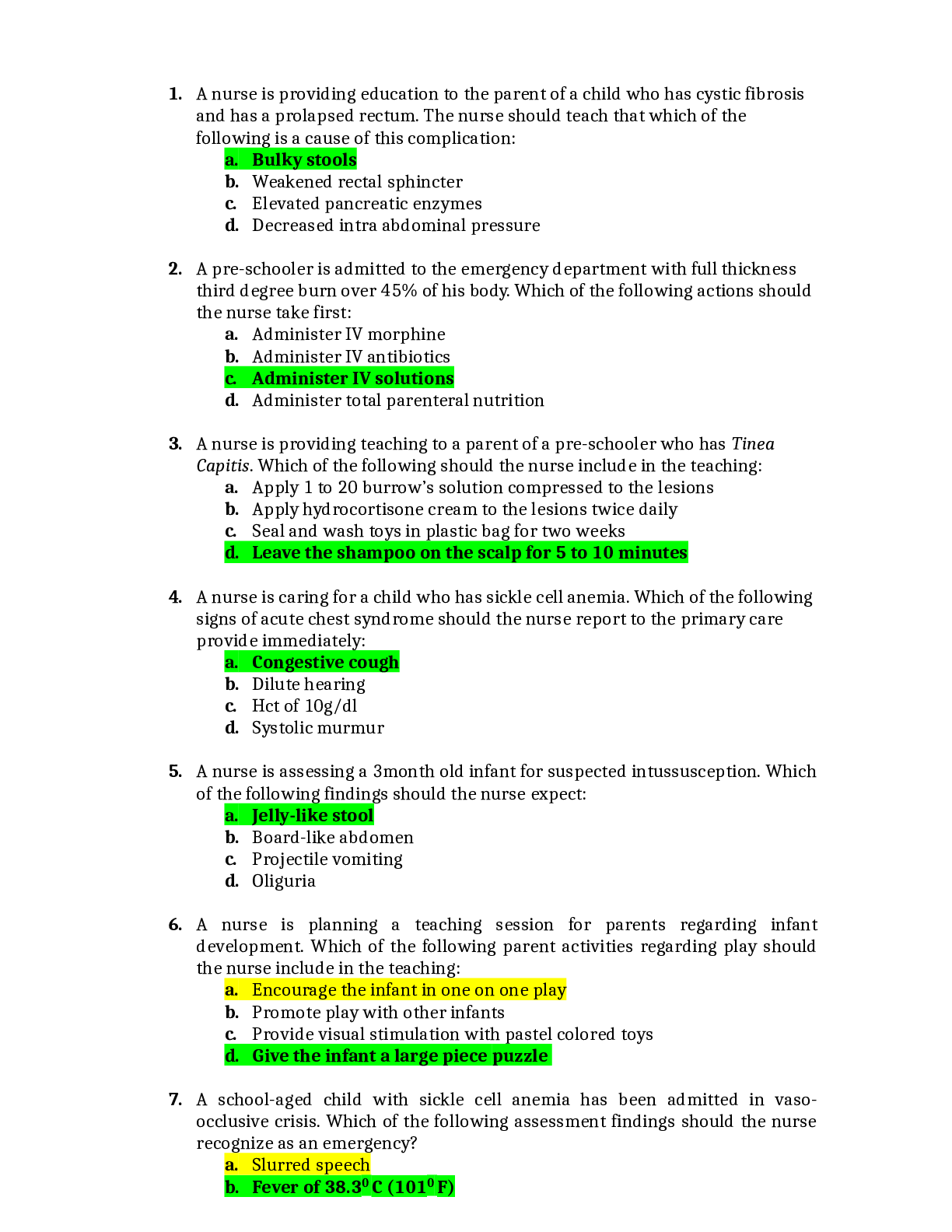
Reviews( 0 )
Document information
Connected school, study & course
About the document
Uploaded On
Sep 02, 2021
Number of pages
11
Written in
Additional information
This document has been written for:
Uploaded
Sep 02, 2021
Downloads
4
Views
295



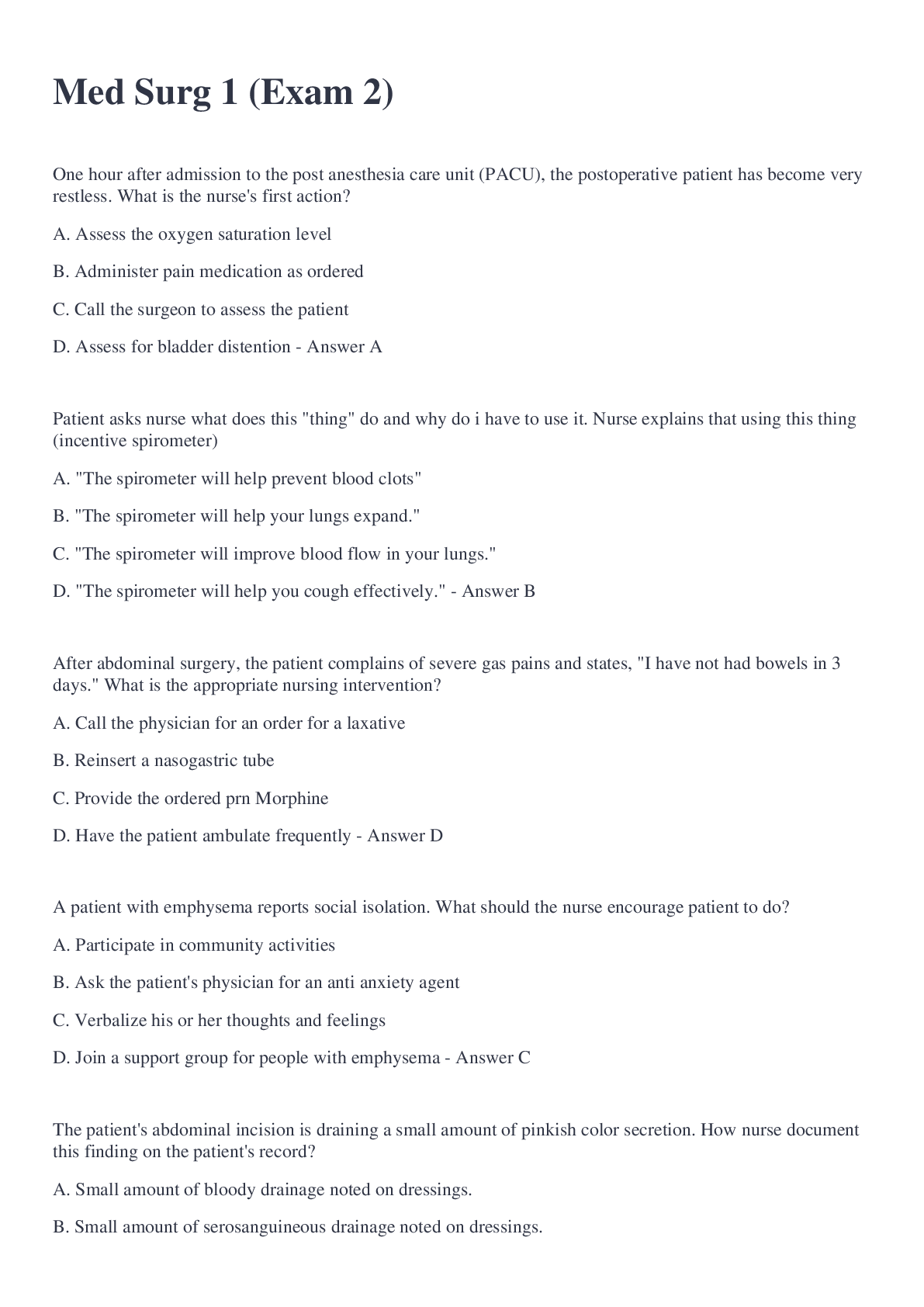
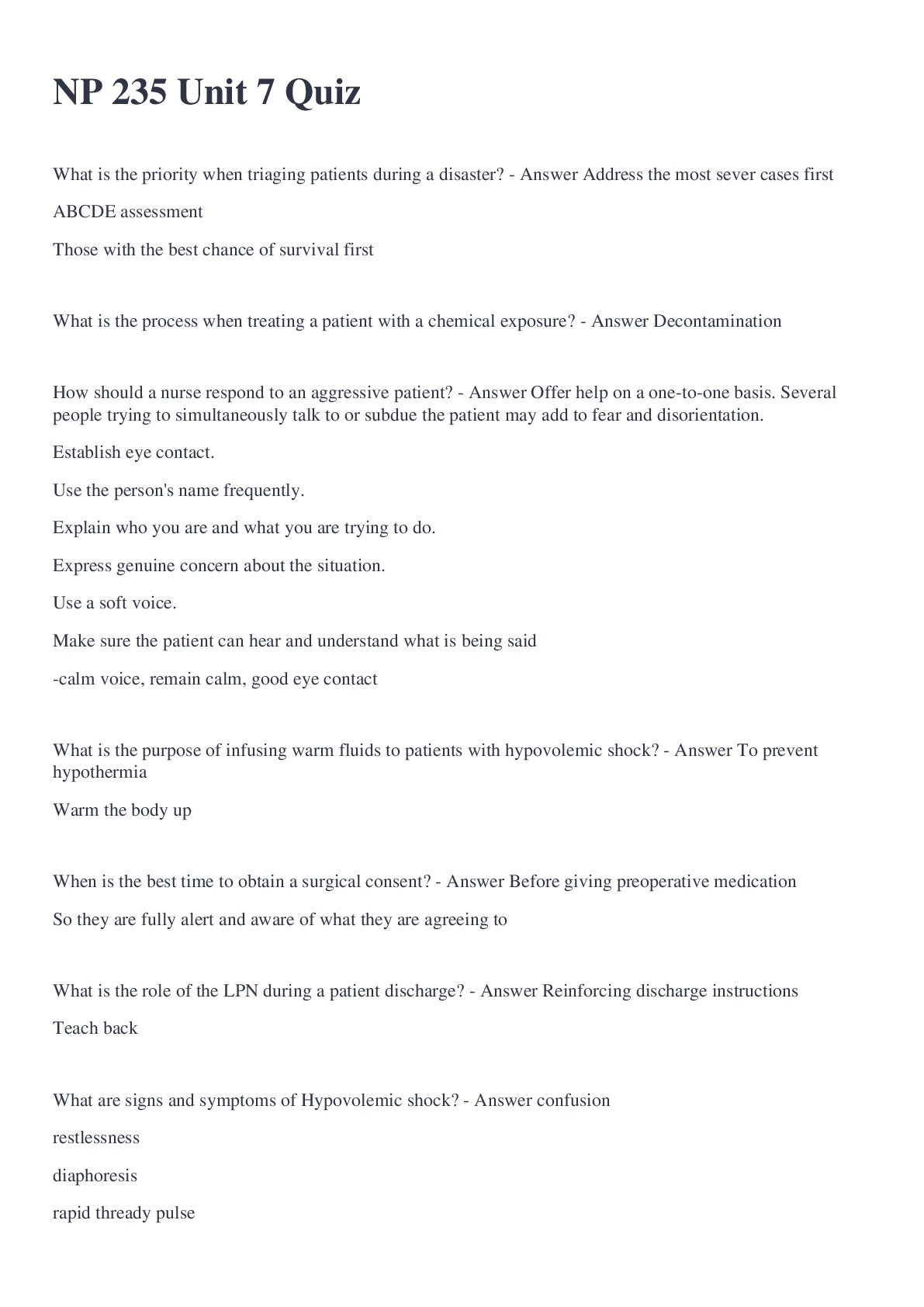

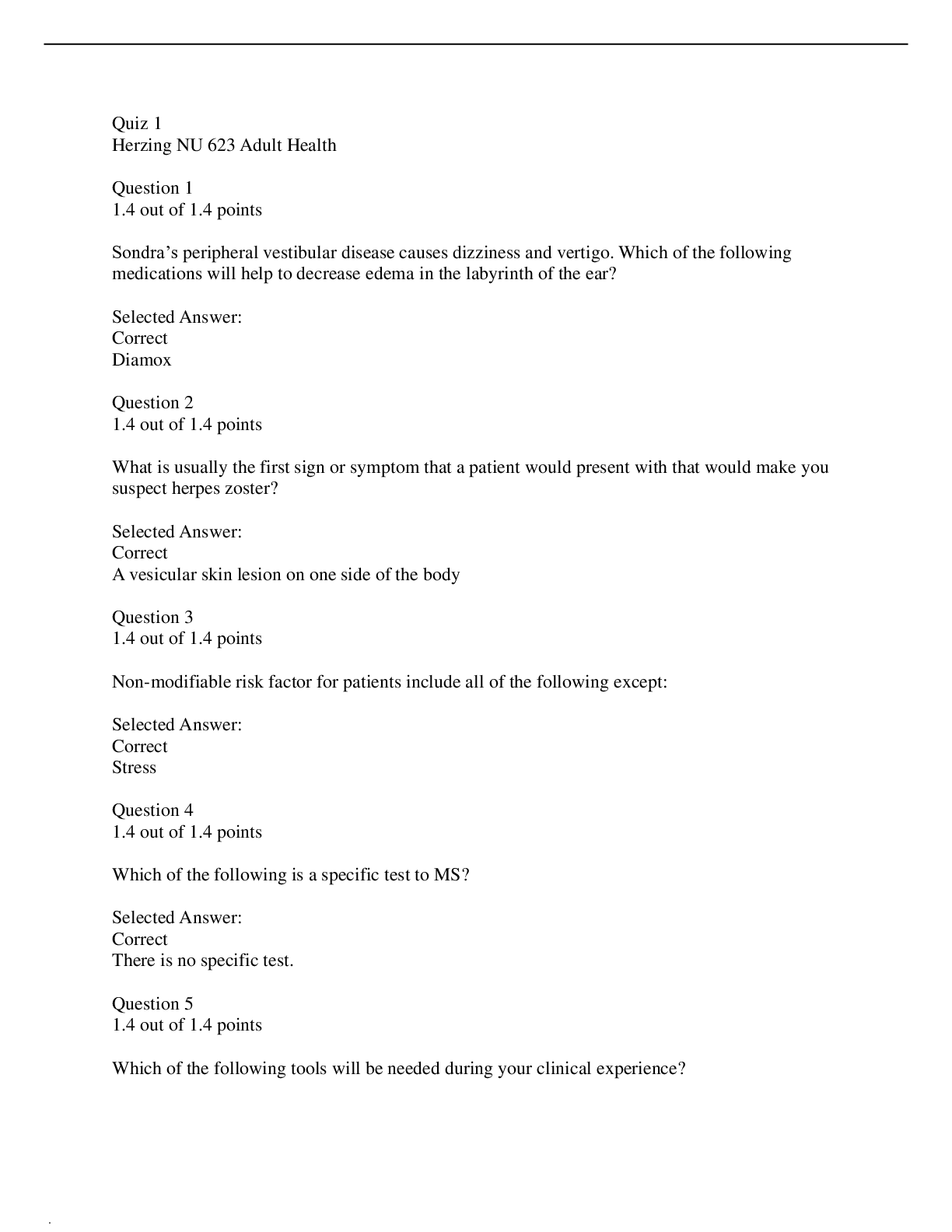
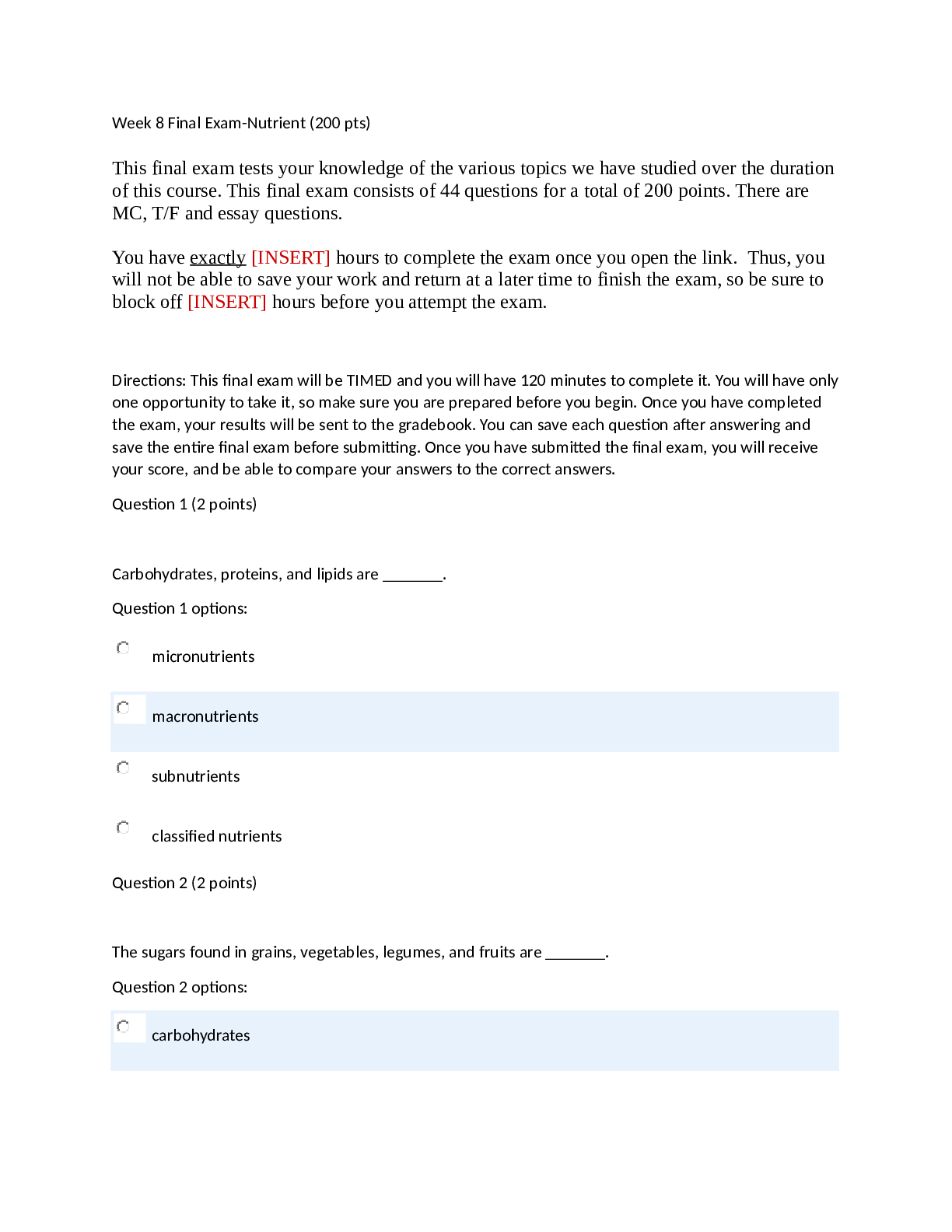
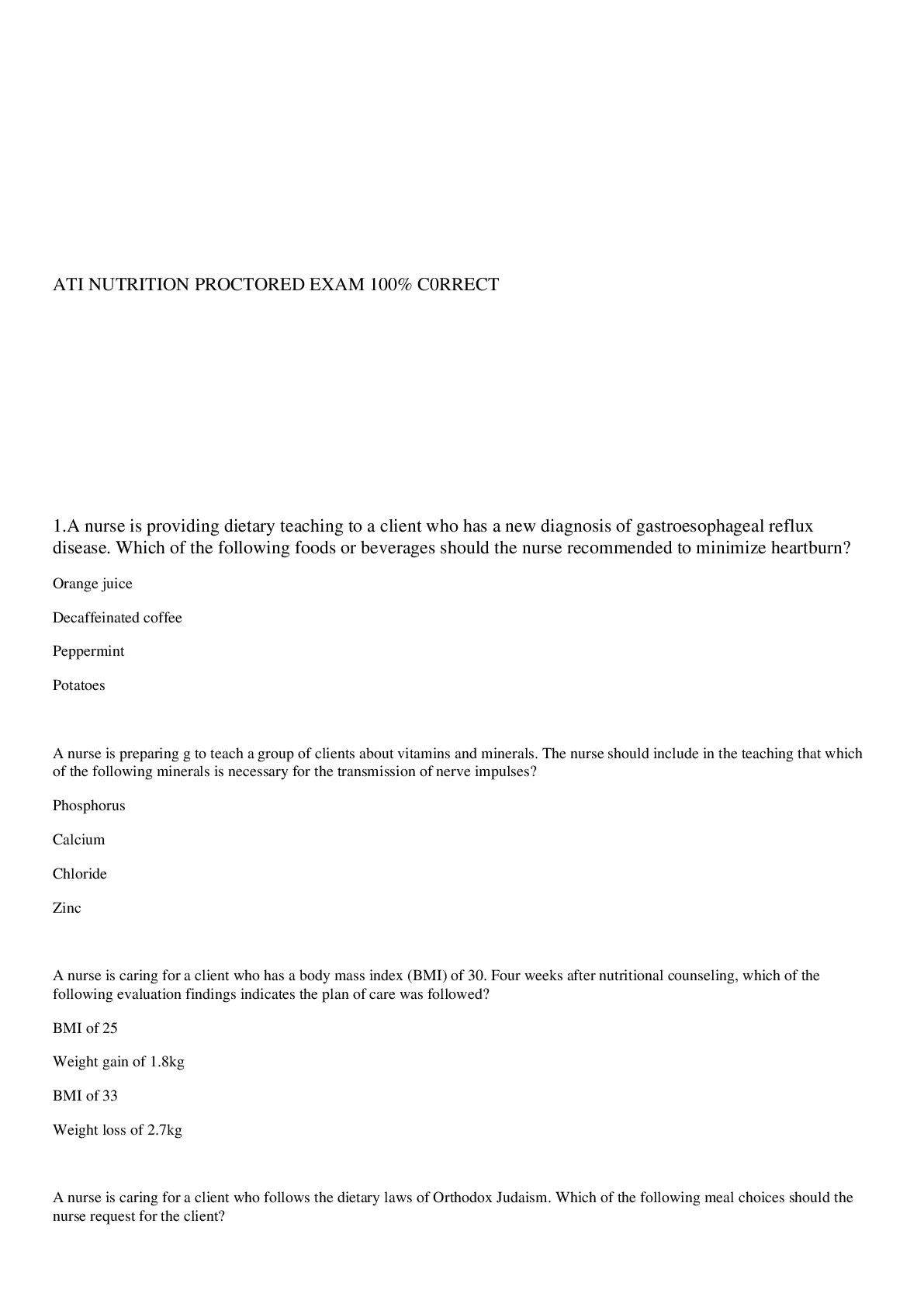
.png)
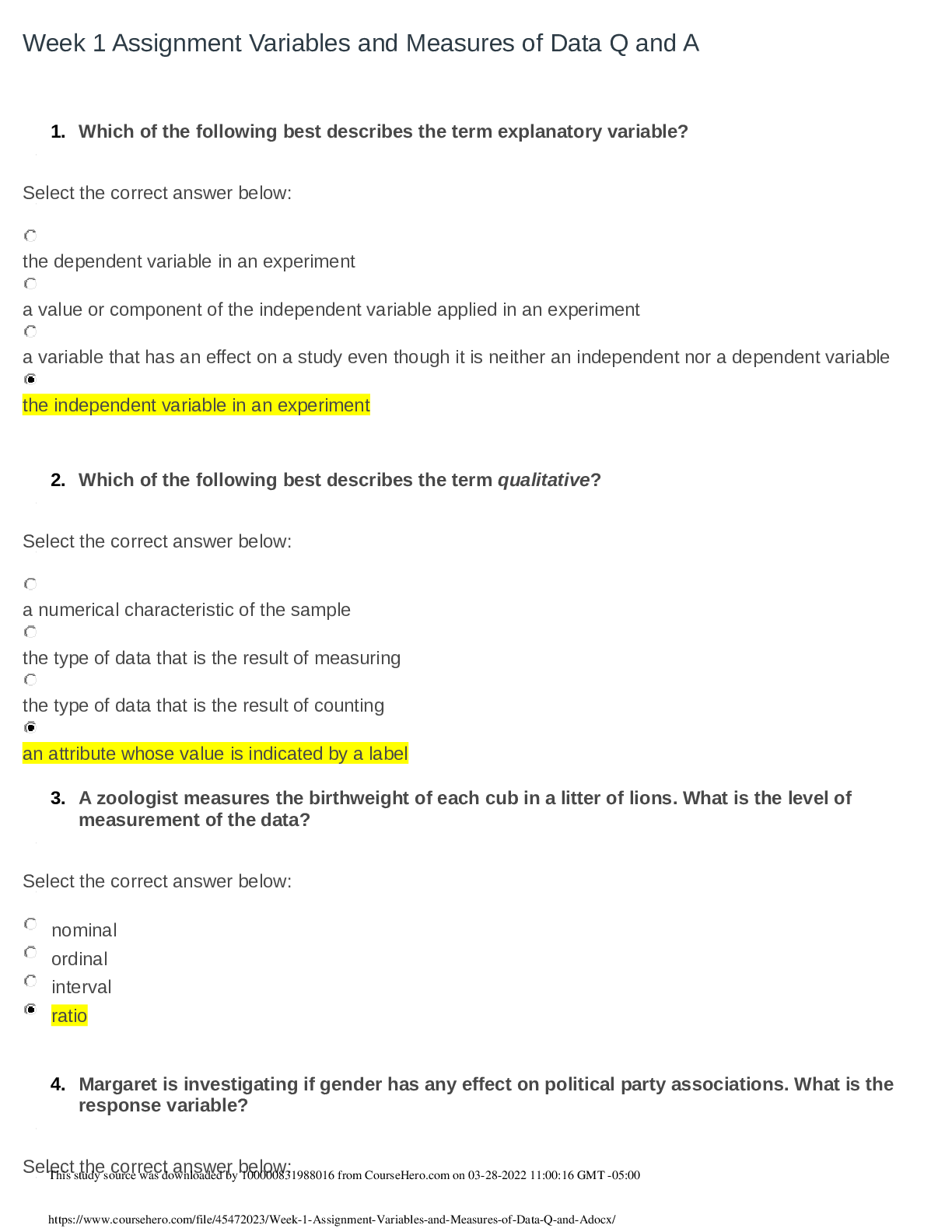
.png)
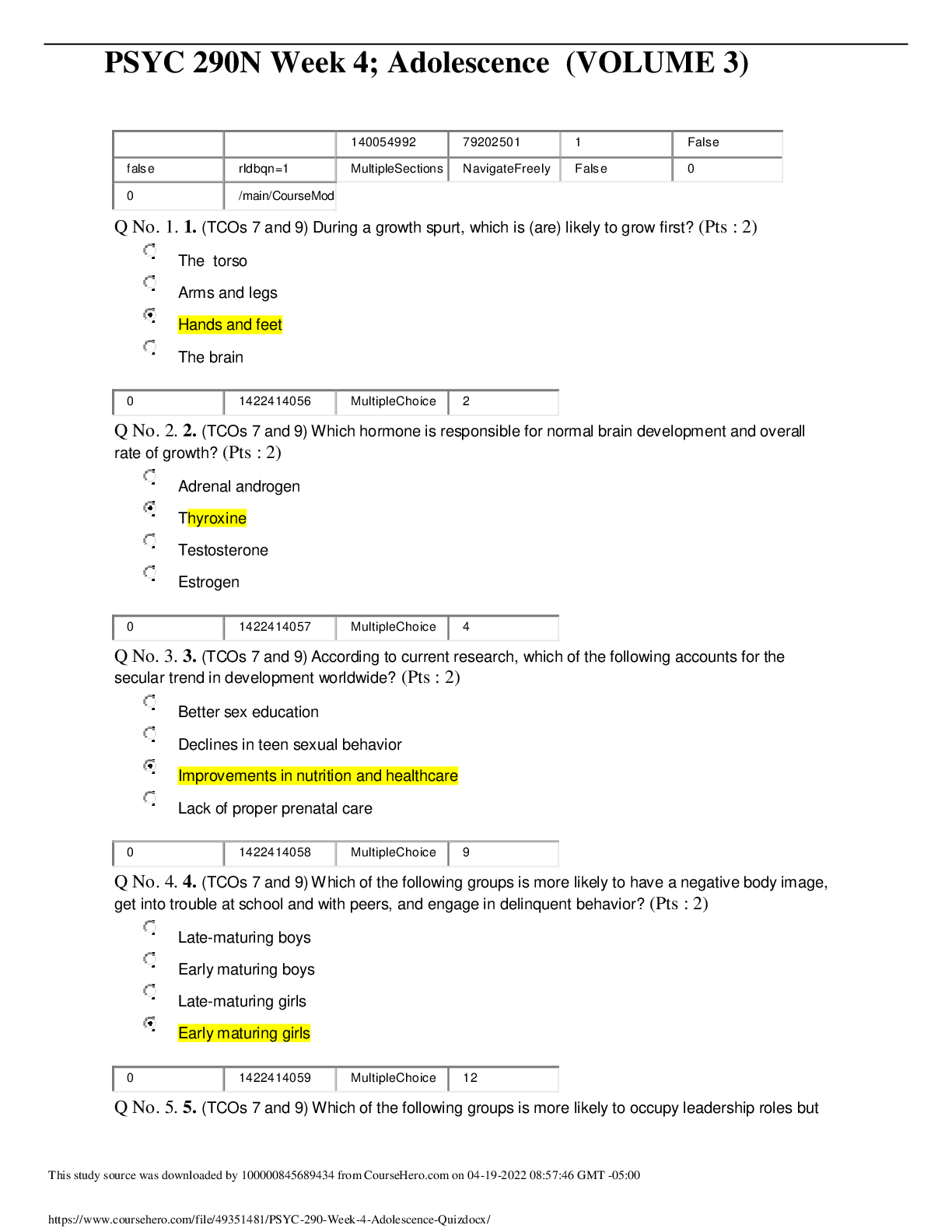
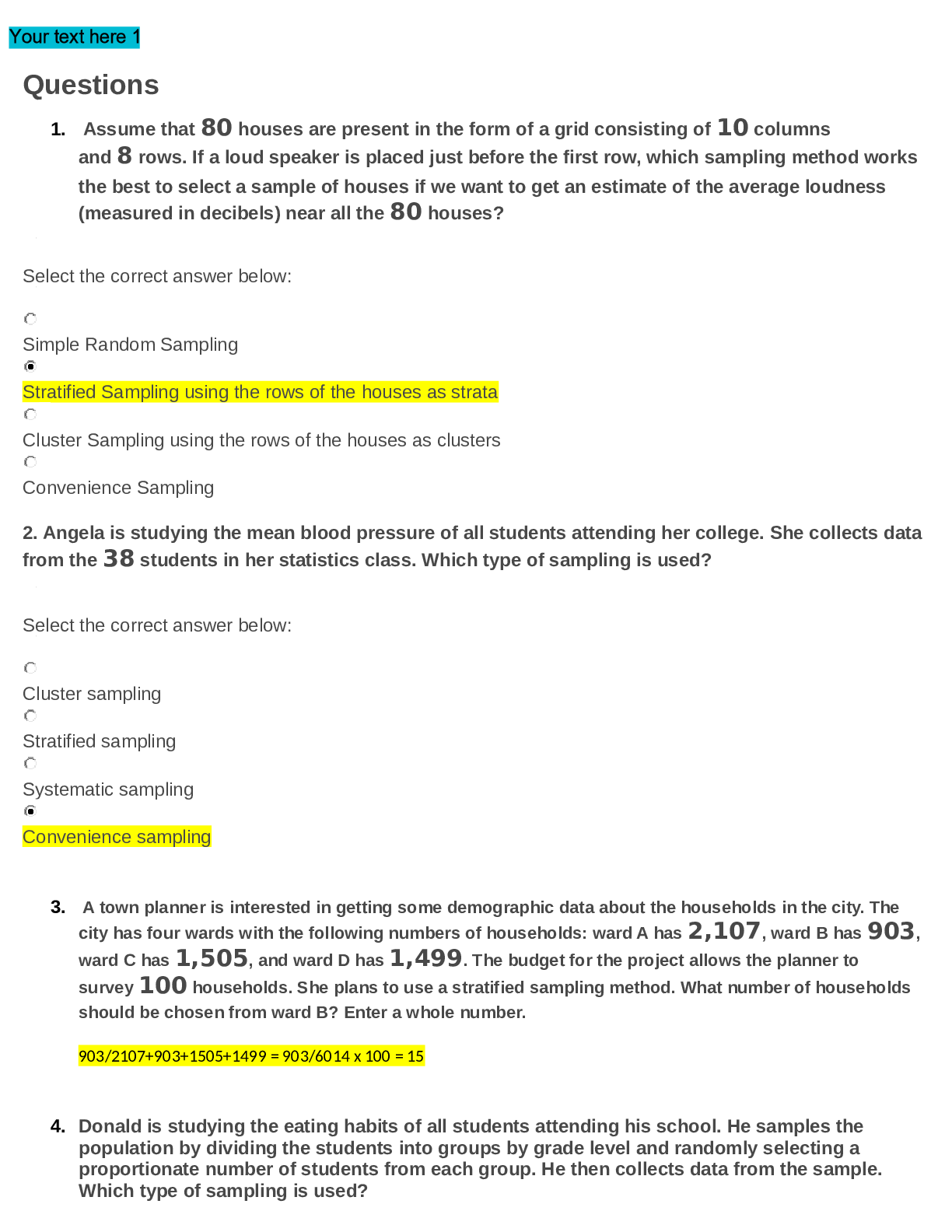
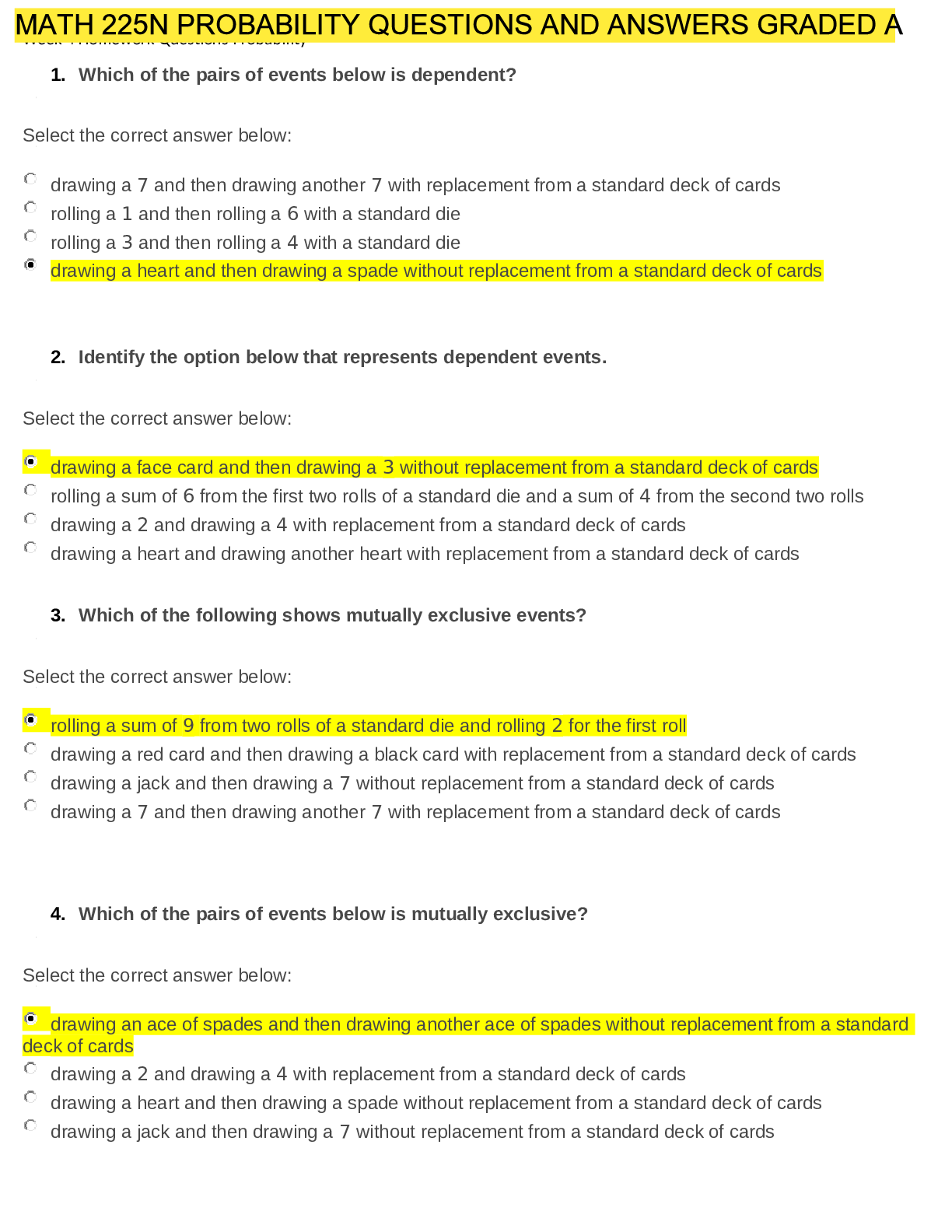
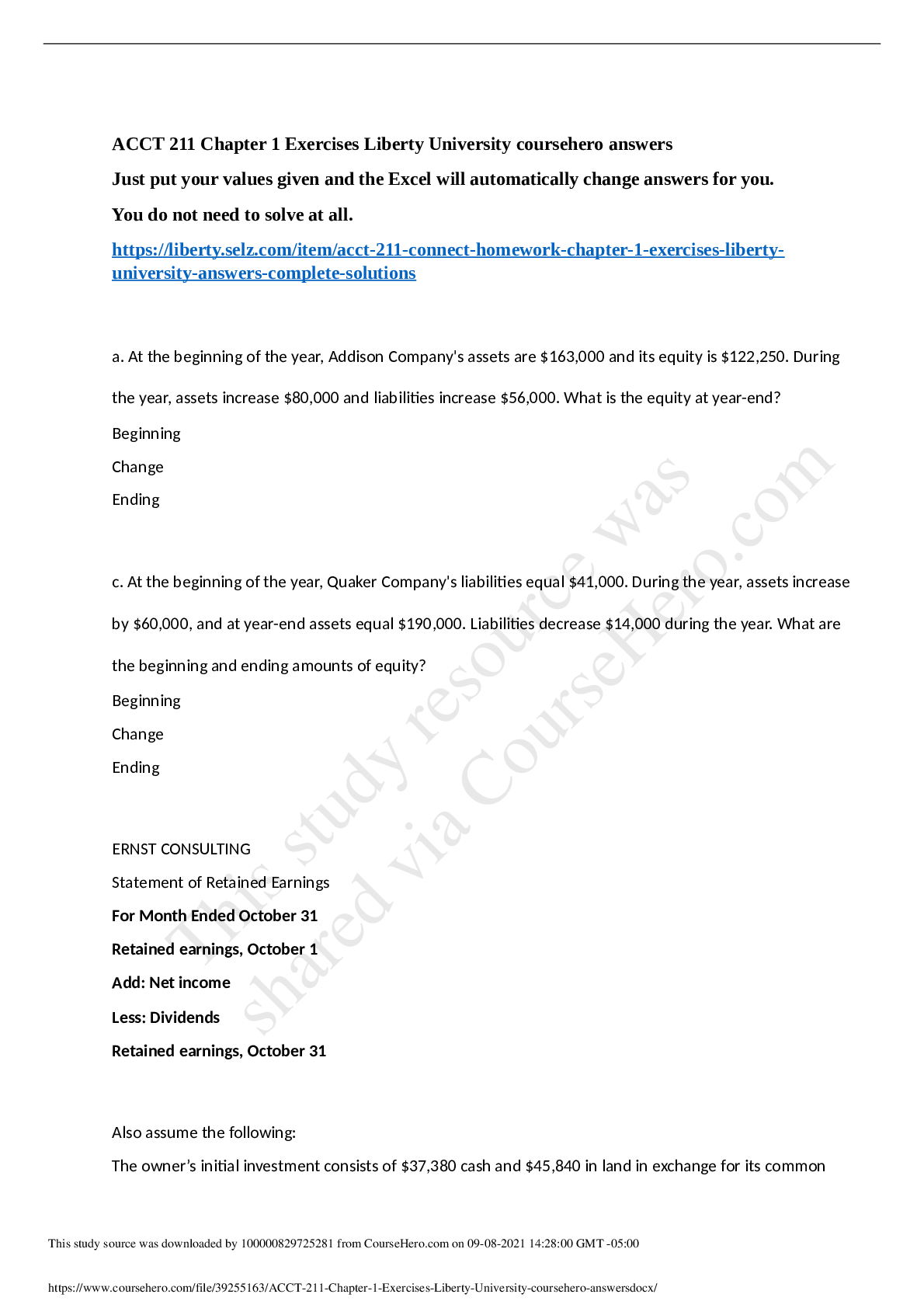
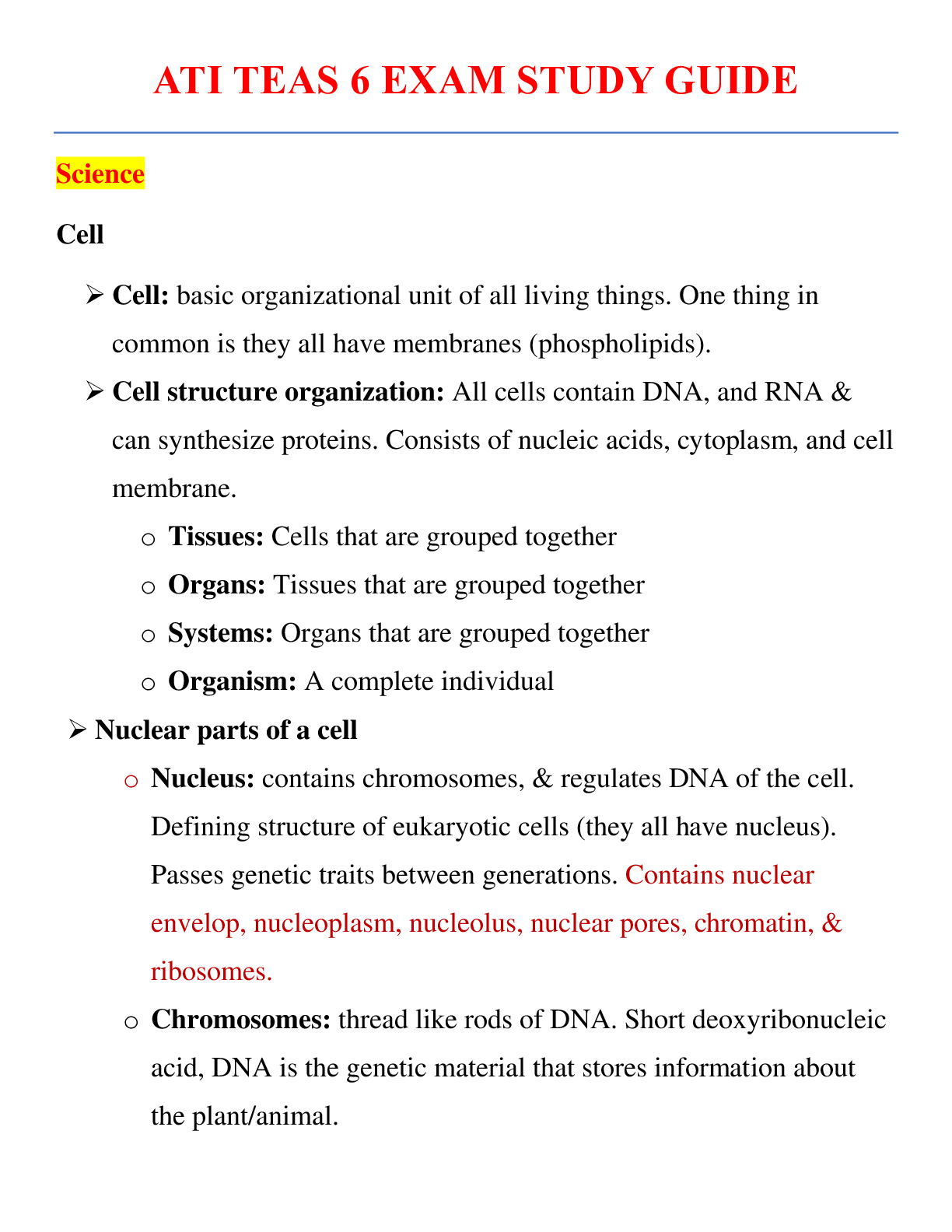
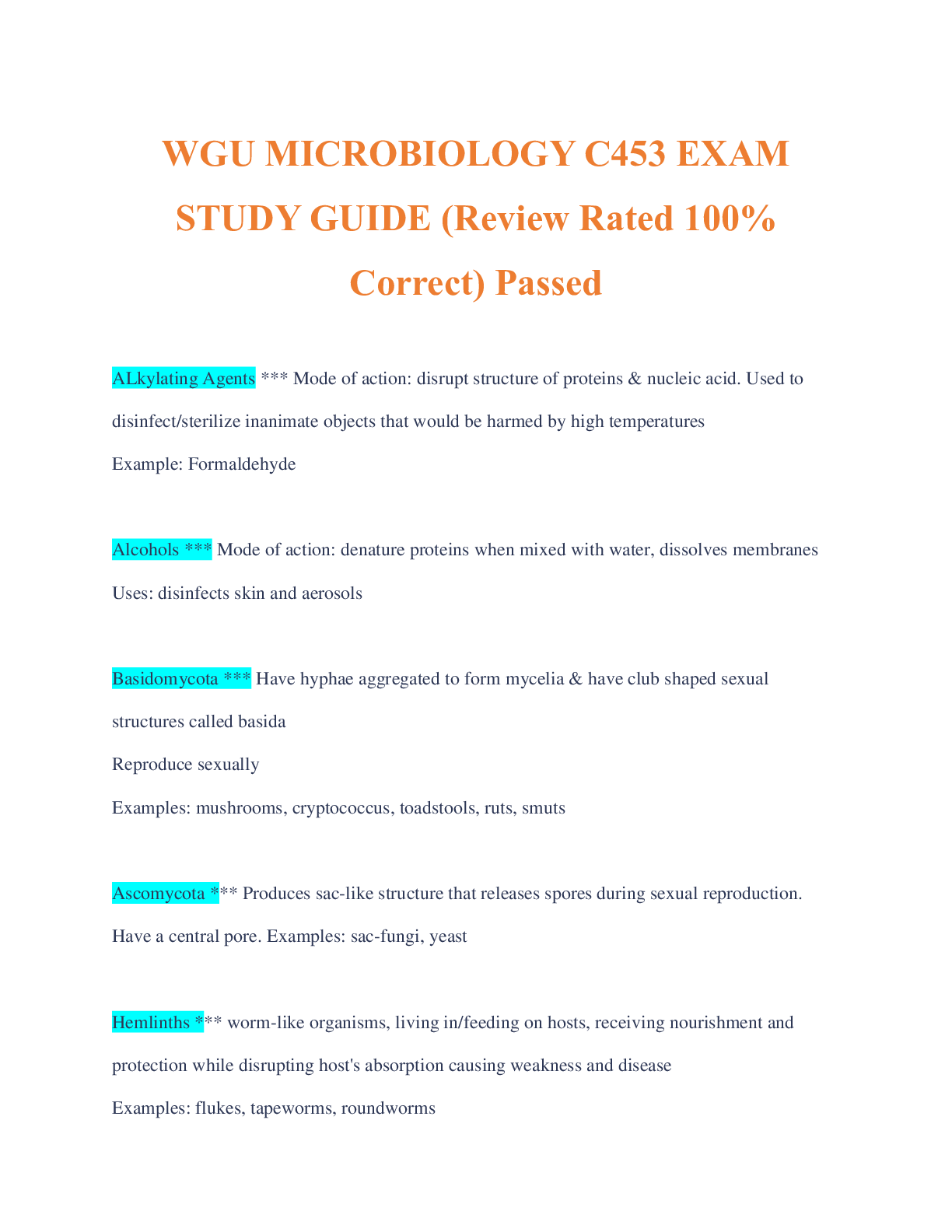
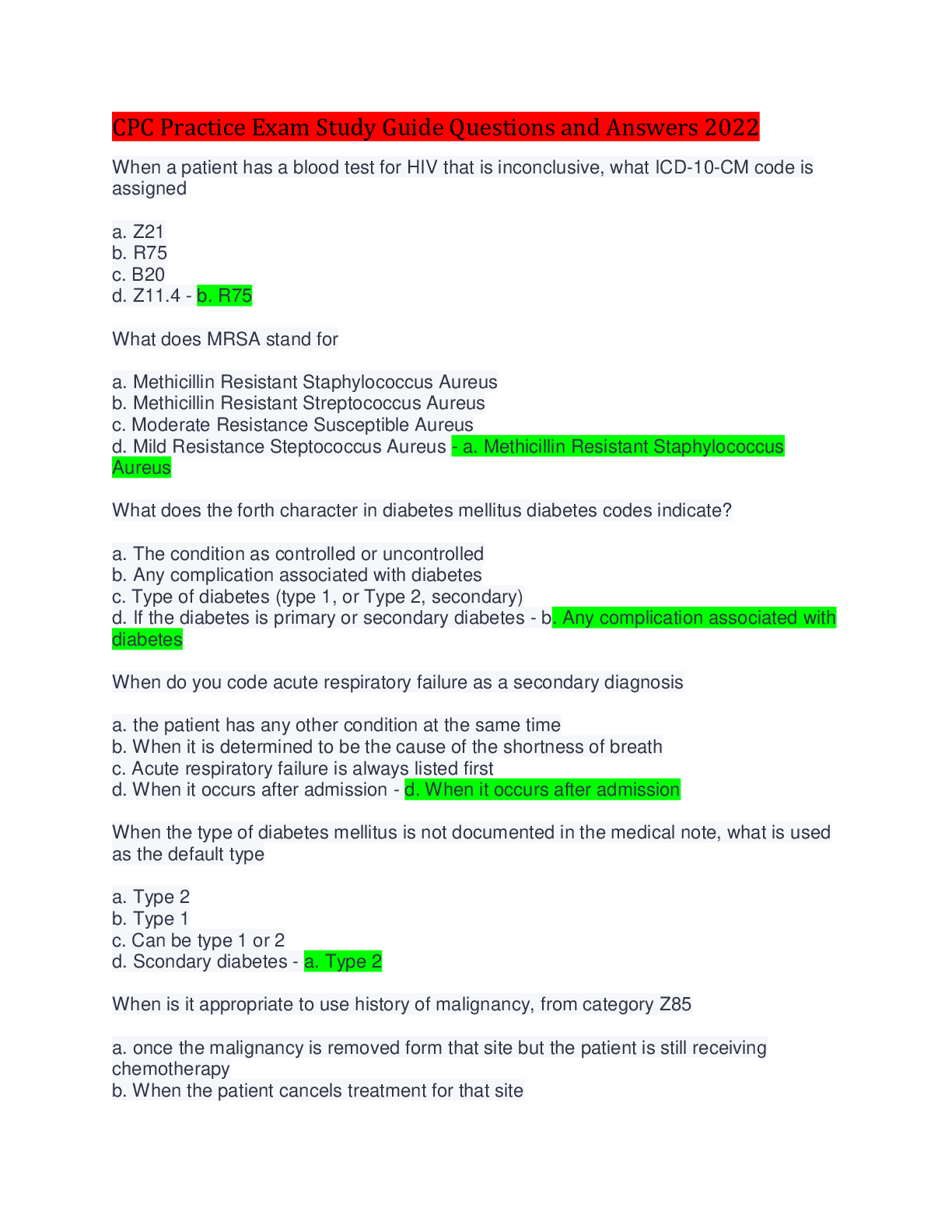
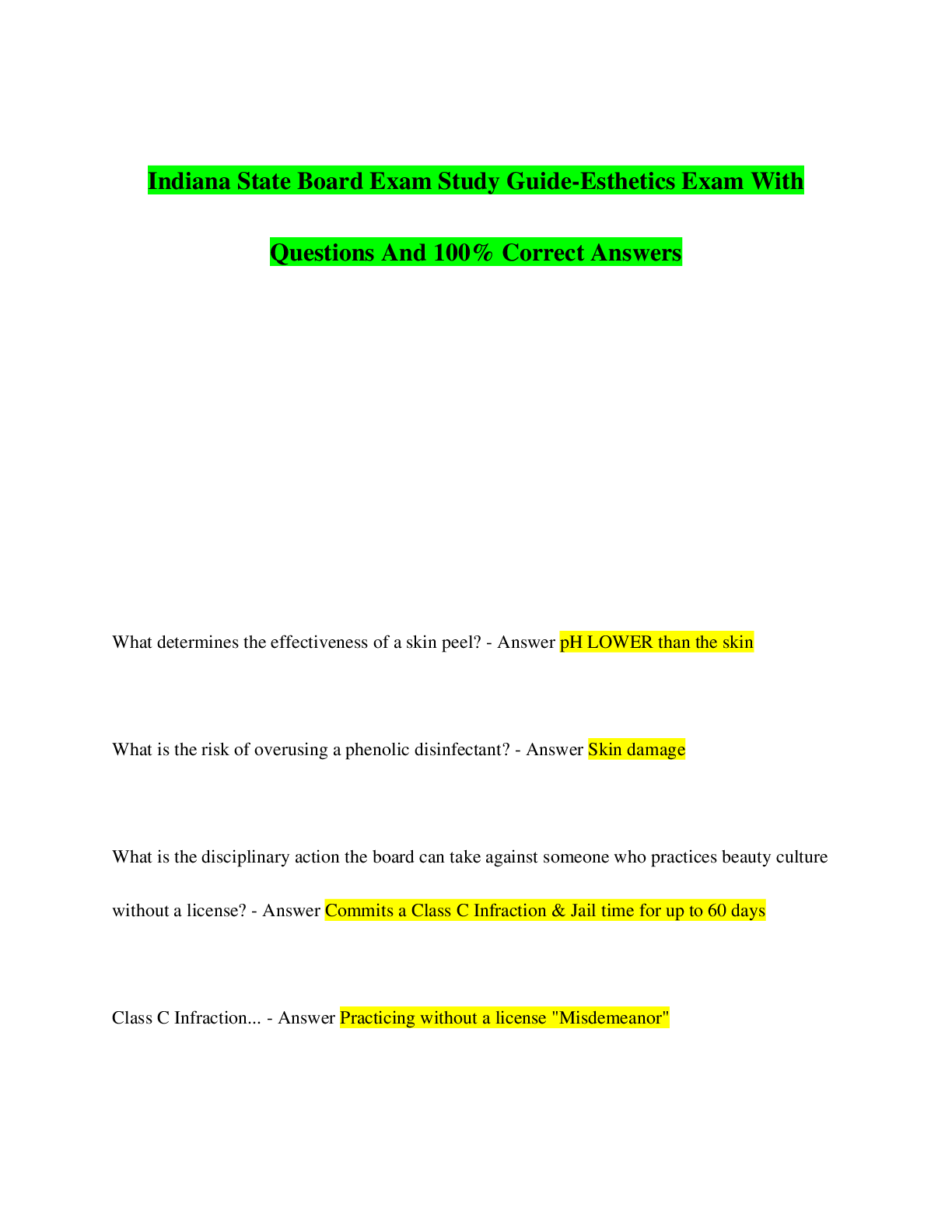

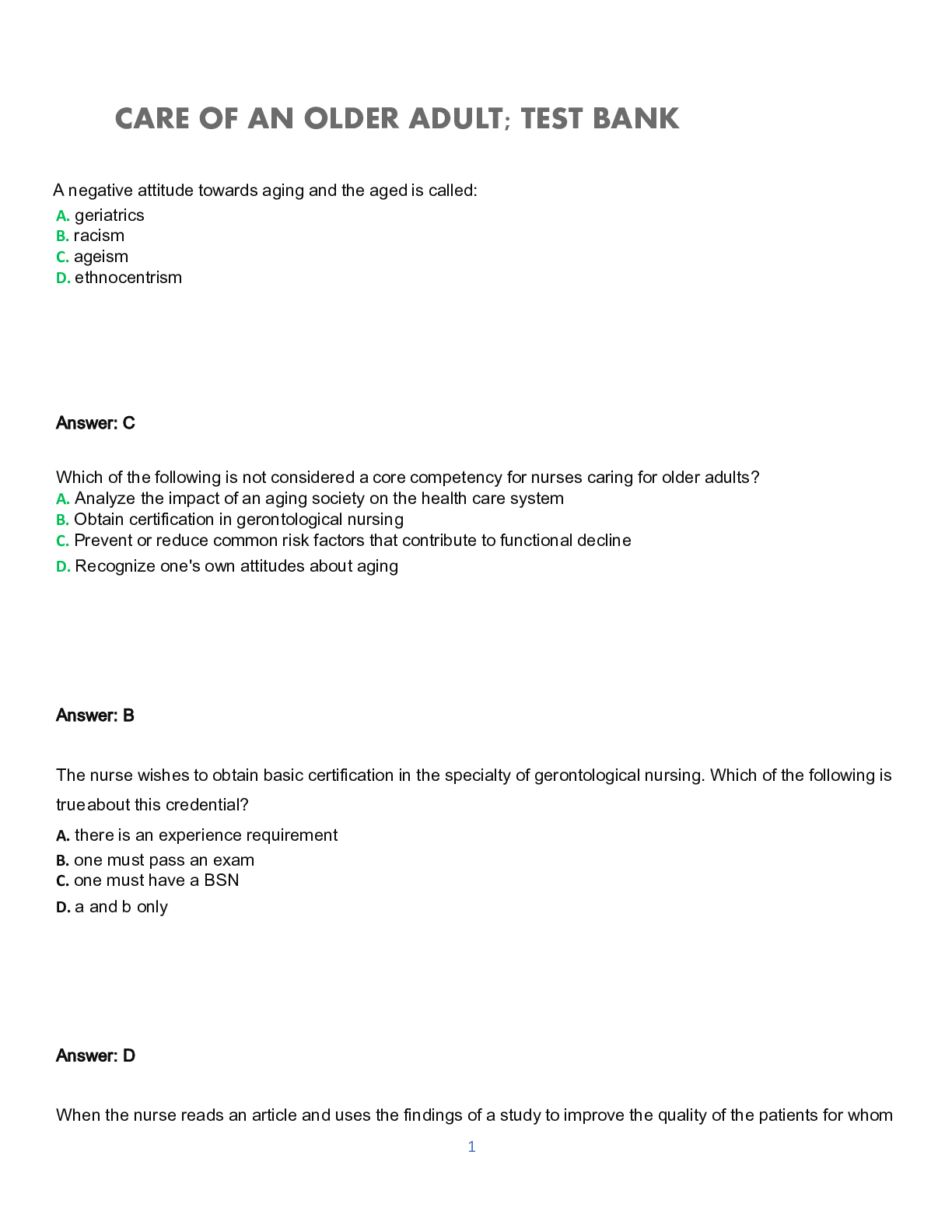
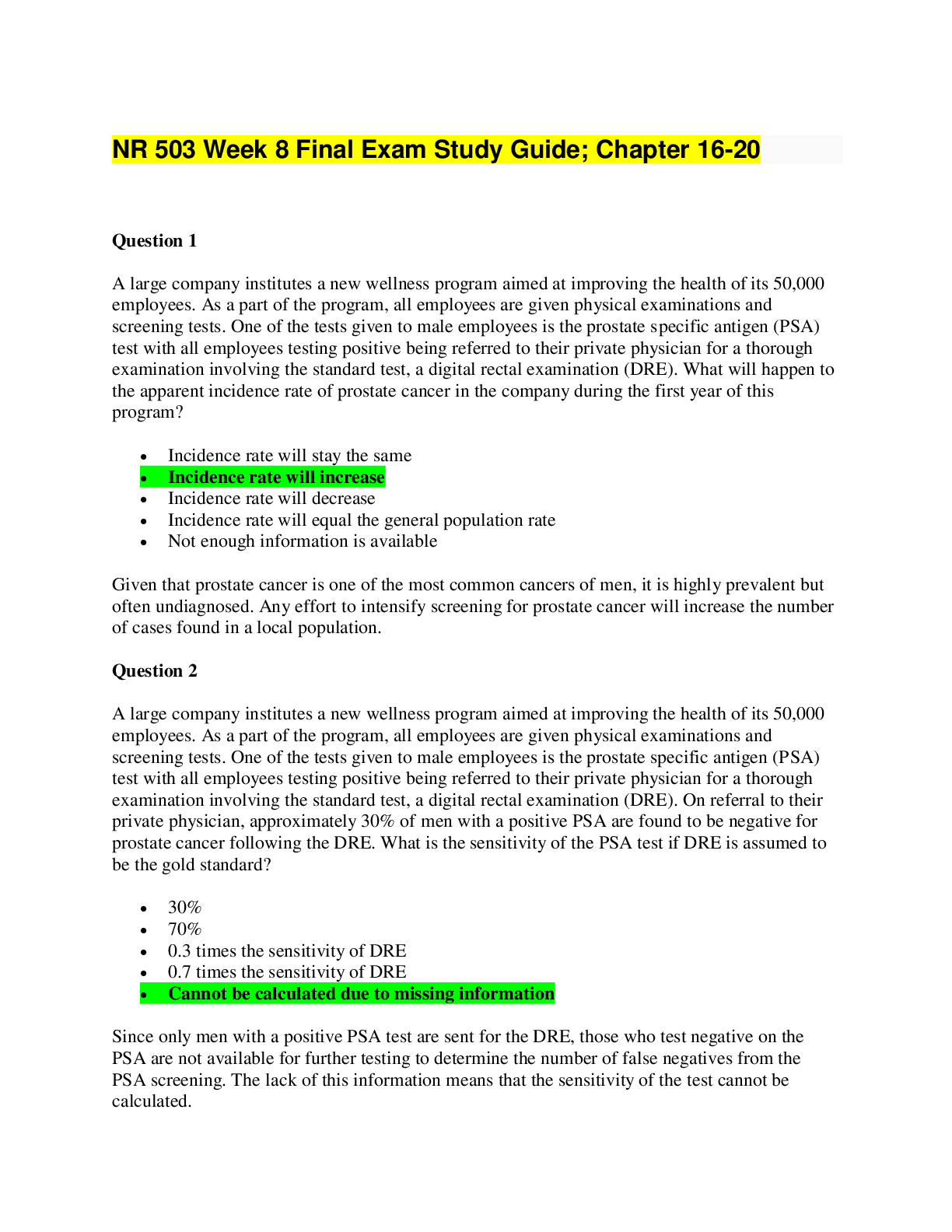



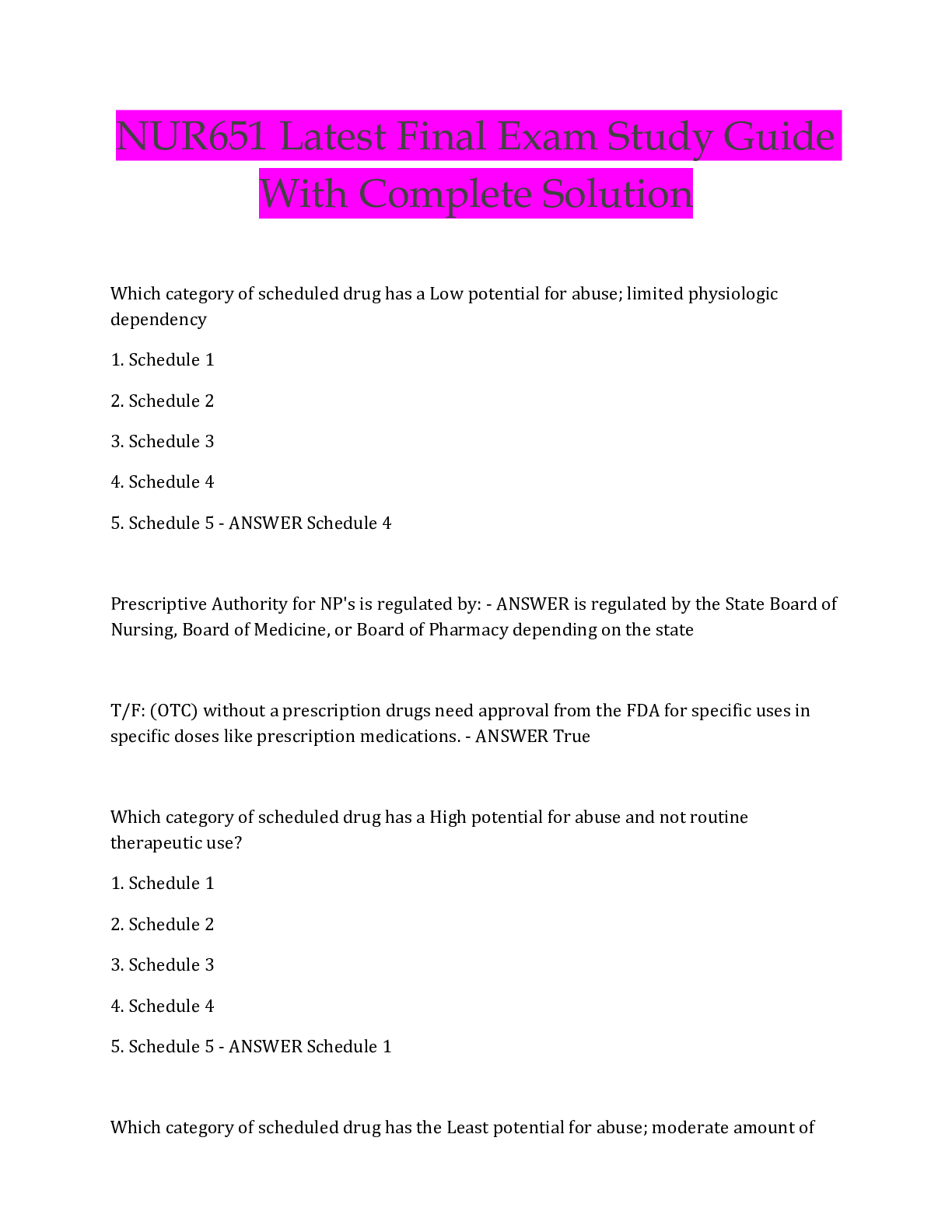
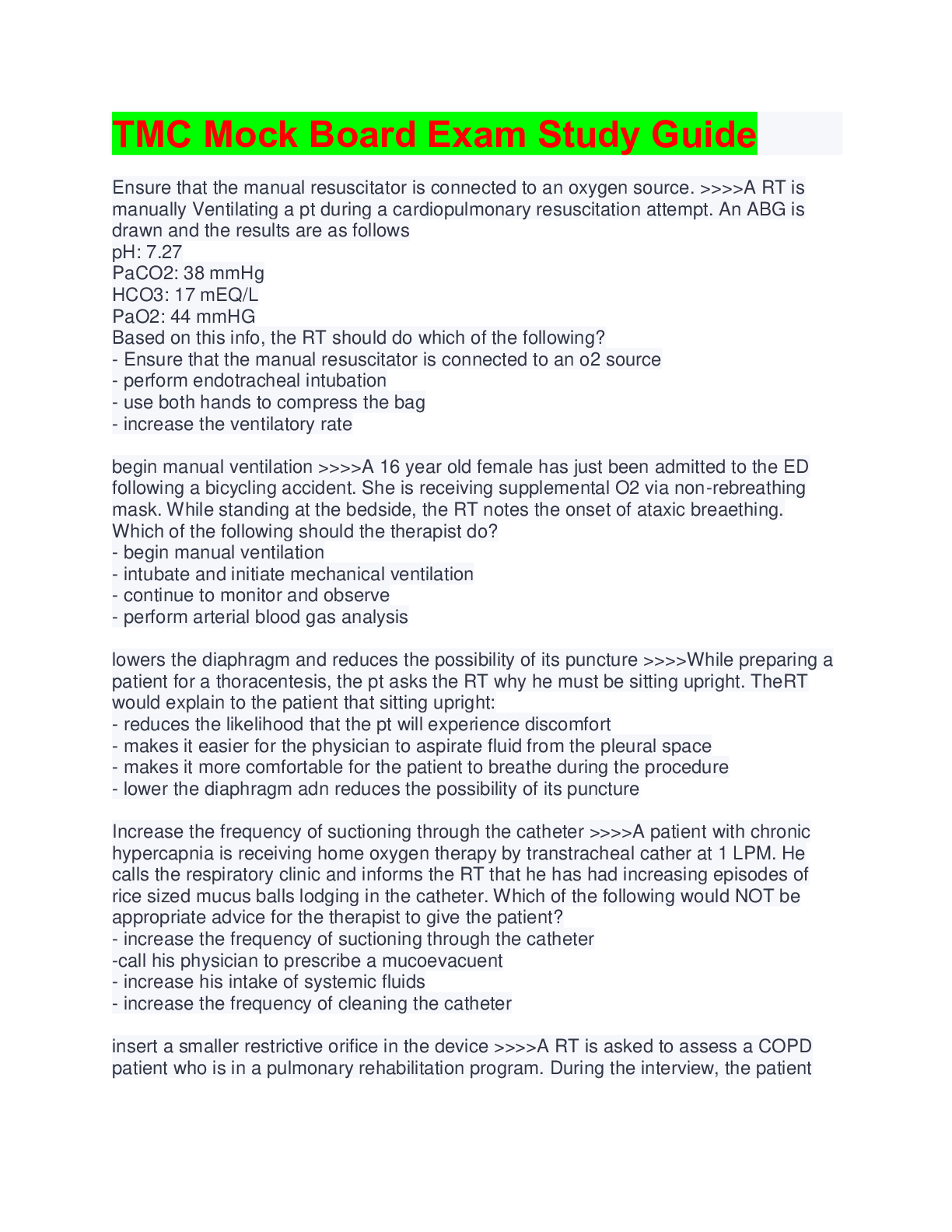
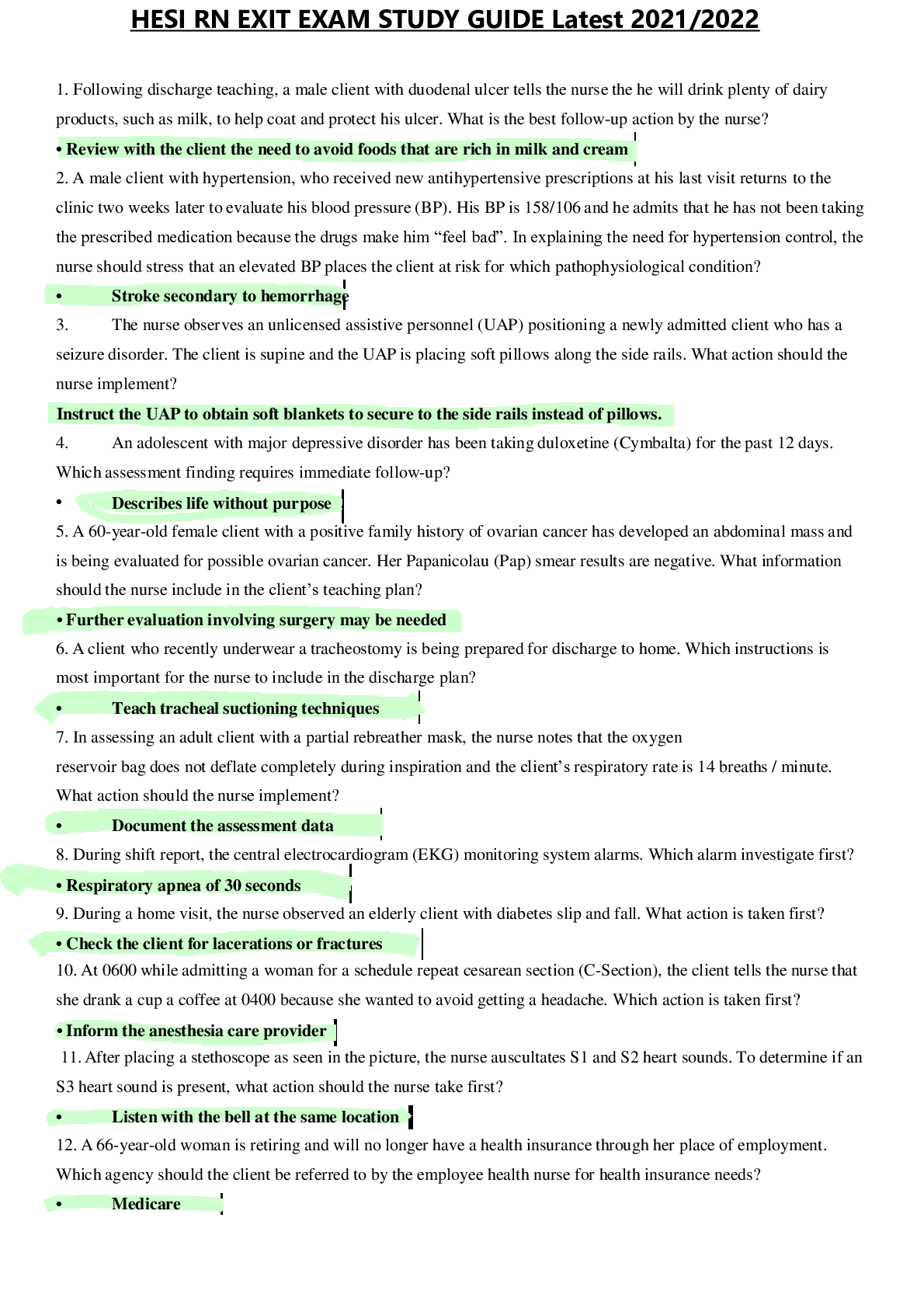
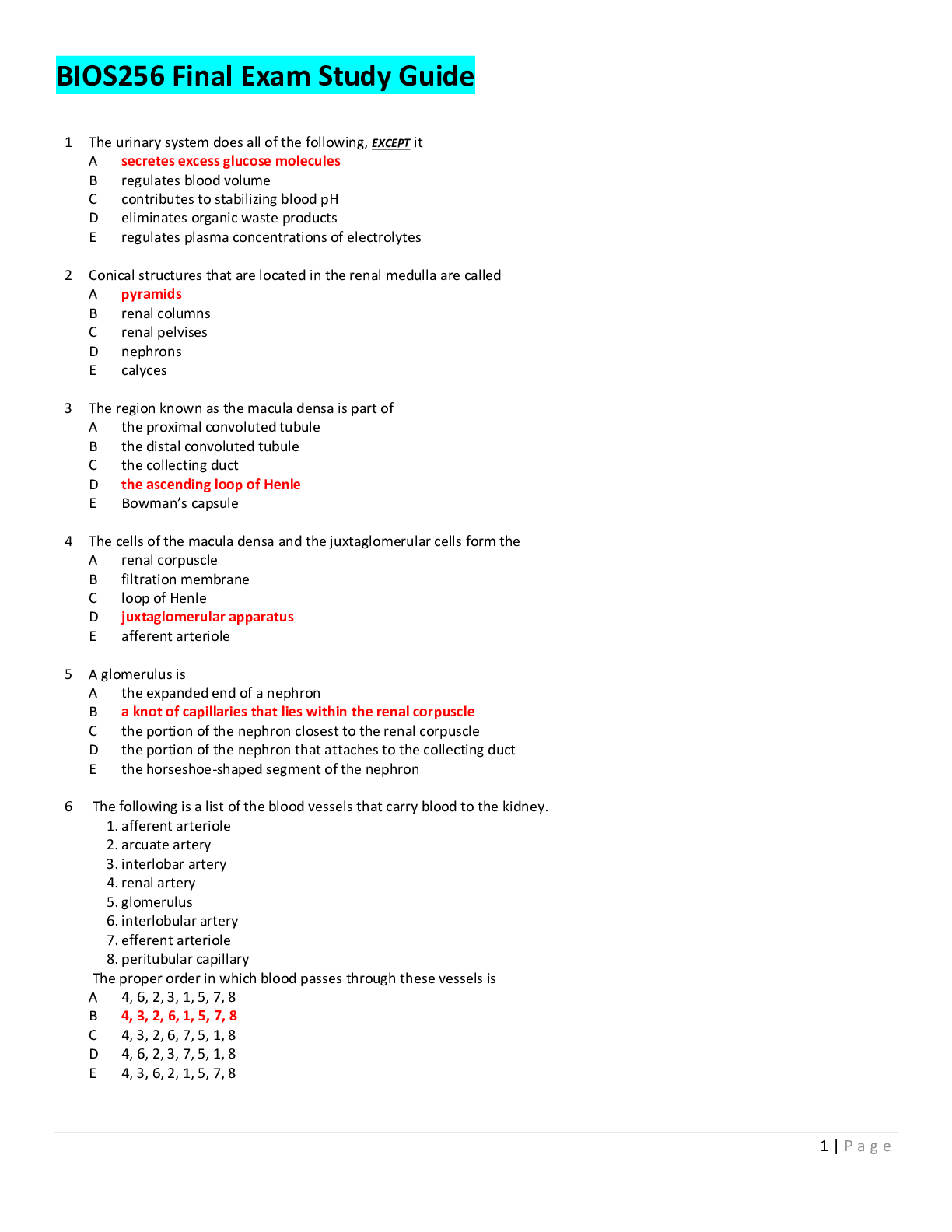
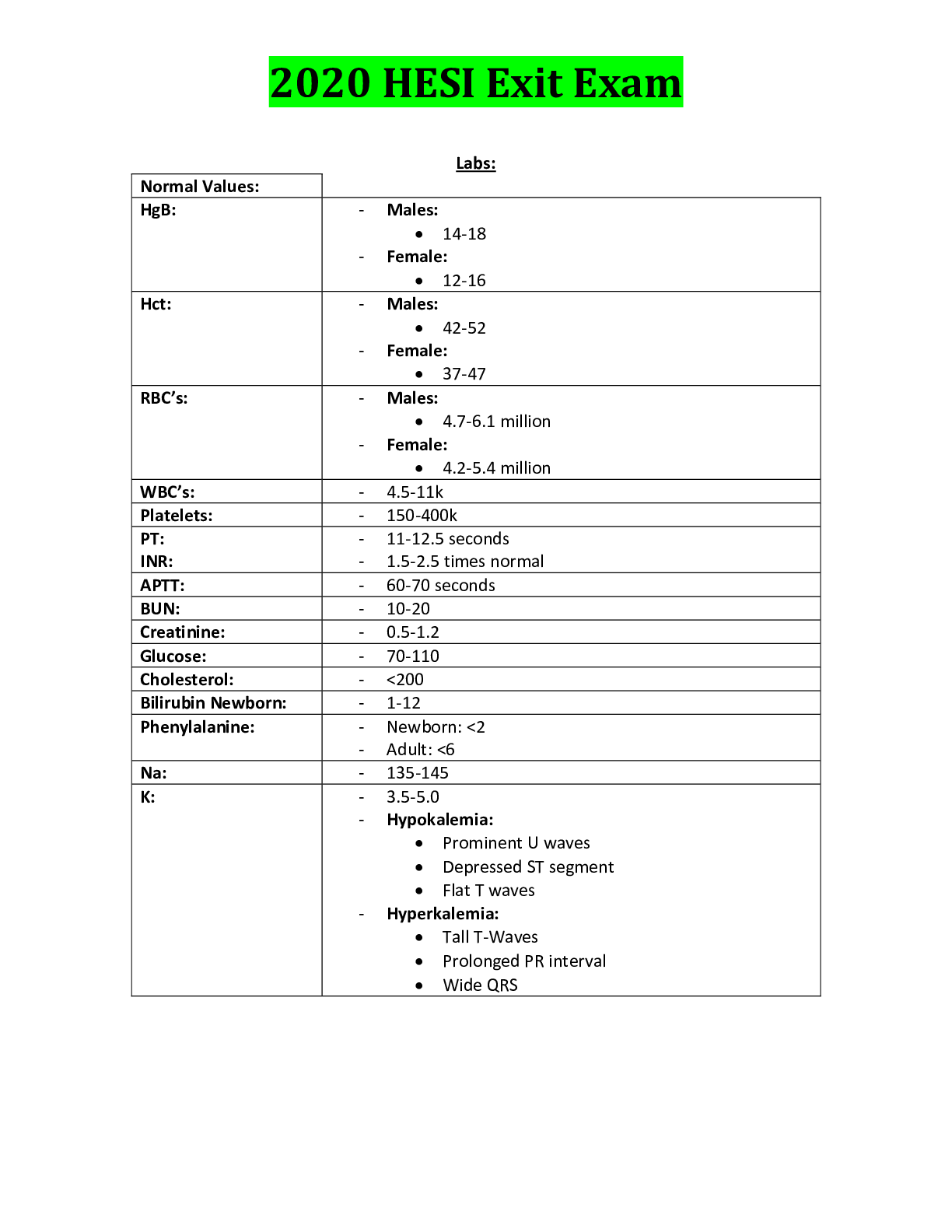
.png)

